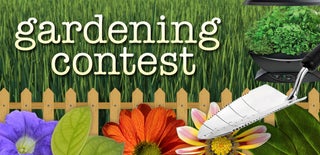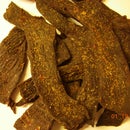Introduction: Bucket Planter
Planter buckets have been done many times, in many forms. This version might be a duplicate of another, but I haven't seen it. The theory is the same as a Earth Box planter, just the technique is a little different. I think this one is fairly straight forward and reusable.
Step 1: Material and Tool List
Material List:
- 5 gal. plastic buckets. ( I used 5)
- 4”X10’ perforated plastic drainage pipe. (About $4.00 at HD)
- 1 ½”x10’ PVC pipe. ($7.00)
- ½” mesh plastic hardware cloth. ($12.00 at the garden center)
- Zip ties
- 4 40lb bags of soil. ( There will be soil left over.). Duct tape
- Re-use the bags from the soil for covers.
- Water
- Organic fertilizer.
Tool List:
- Utility knife
- Some kind of saw ( Optional)
- Drill
- ½” Drill bit
Step 2: Creating Reservoir
We’ll start with creating the reservoir. To do this I wanted to place two pieces of the drainage pipe in the bottom of the bucket. I had to have an angle on the pipe to be able to fit both of them in. By trial and error I found 45 degrees worked pretty well. The length you have to play with a little. I counted 4 of the ridges on the pipe and used that of a reference.
The way the pipe lays in the bucket and just the way it’s shaped, I realized the a lot of the soil would end up in the pipe, not allowing much room for water.
This is where the hardware cloth comes in. Although you want some soil to be down in the reservoir to act as a wick to bring water up into the main body of the planter, if too much soil is there it will create more of a swamp and the main body won’t be able to drain properly. As water is absorbed a void is created in the reservoir to allow any excess to drain back into reservoir letting the system self-maintain soil moisture.
So, we have the pipe pieces cut, now cut a piece of cloth just long enough to wrap around the pipe wit the excess folded over opening. Nothing exact, the idea is to cover the ends to block soil from filling the pipe, so whatever works is fine. Simply attach the cloth with a zip tie. Once you put the soil in it will hold everything in place.
Now comes the fill pipe. I measured from the bottom of the bucket up to a couple of inches above the rim. Mine ended up 16” to the long point of the angle. The angle helps the water flow out of the fill pipe. The actual angle isn’t important, I used a 45 just to get as much flow out of the pipe as possible.
Step 3: Put It Together
Putting the thing together is easy. Nothing is really attached, so everything just lays in the bottom until you add soil.
If the drainage pipes were cut tight enough there won’t be a lot of space between them. Place the wrapped pipes in the bucket. Take the fill pipe and jam it in between the two pipes, creating a space that will be filled with soil.
Make sure that the short side of the angle is facing the wall of the bucket (see photo) or soil will probably block the flow of water.
Step 4: Drain Hole
A drain hole serves two purposes. The first is to let you know when the reservoir is full. The second is to drain(duh) excess water.
The height of the hole should be a little below the level of the top of the wrapped drainage pipe so that when the reservoir is full, there will a void between the water and the level of the main body of the soil, allowing well drained soil.
It may sound a little complicated but all you have to do is make sure that when the reservoir is full the water doesn’t touch the main body of the soil.
I drilled a ½” hole. Filled the bucket with water with no soil and checked the water level.
In the first bucket( I made 5) my first try was to high and the water was as high as the soil would be. I just drilled another hole a little lower. The extra hole won’t hurt anything. Re-filled the bucket, checked the level again, measured the height of the hole and drilled the rest of the buckets.( Shown in picture)
Five buckets took me around two hours to complete, and be ready to plant.
Note:
Try to drill the hole where there will be no soil so that the water flows out easily and makes less of a mess. Also try to drill the hole near the fill pipe as to easily see when it's full.
Step 5: Planting
I’ll try to keep this step as short as possible.
You have as many options as you have plants that you can grow.
Here are a few things that I did.
1. I filled the buckets half way, added a layer of fertilizer, then filled in the rest of the soil and added plants.
2. I only planted one tomato plant per bucket. I felt comfortable planting two pepper plants in one bucket, they did fine last year.
3. I used plain potting soil mix, nothing special, just a 1:1 mix of top soil and potting soil. It made a nice loose mix.
4. When first filling with soil, make sure that you fill all of the spaces around the wrapped drainage pipes with soil to create the wicking action needed the self-water the planter.
A couple more notes on planting.
After planting, make sure that the soil is mounded up higher than the top of the bucket so that after the plastic cover is installed, rain water will run off and not collect on top and run into the bucket, that would wash out all of the fertilizer. You want all of the water to come out of the reservoir so that it is self regulating and the plants get to use all of the fertilizer.
The cover is just re-used plastic bags cut to size. Cover tightly enough to seal out as much rain water as possible. There can be some small openings, but that's OK there needs to be some air flow to get oxygen to the roots.
I'll try to add some photos as the season progresses. This is our third year with either Earth Boxes, buckets or both.
Step 6: Buckets in Inaction
Just a couple of pics of the finished product.
I sat the planters on small racks that I made out of some left over rail spindles to minimize damage to the deck.
You can plainly see the re-used plastic bags from the soil covering the planters to keep out rain water. ( Nice tape job, huh.)
Also shown is using the fill pipe to replenish the reservoir.
You can see how the simple drain hole works in the third picture.
Picture number four shows the irony of a sealed system, watering plants in the rain.
Step 7: 7 Week Update
Time for the update.
After 7 weeks in the buckets things are looking pretty good. We are starting to harvest a few tomatoes, and a couple of peppers with a lot more coming on fast.
It looks like we are going enough that we are already worrying about what we are going to do with all of our harvest. We took baby steps into canning last year and plan on trying put up a little more this season.
We planted five buckets, including, by bucket number:
- One Beefsteak
- One Early Girl
- One Hot Banana pepper and one Bell pepper
- One Jalapeno and one Cayenne
- One Cherry Tomato
In years past ( all three of them) we had problems with bloom end rot and we lost a lot of fruit. So this year I tried to be more pro active and treated the tomatoes with a solution of hydrated lime, mixed as per package directions, added to the reservoir at about the four week stage, just after the plants started to fruit. So far so good.
All of the tomatoes are of the indefinite variety, meaning that the plant never stops it's upward growth and gives an ongoing harvest as opposed to definite varieties that tend to grow to a given size and whose fruit tend to ripen all at once.
Most people say that indefinite varieties should not be grown in containers, that they grow to big, Well, that's what our experiment was this tear, to find out if the bucket system could withstand the intense growth of an indefinite plant.
As for the the individual plants: (I tried to keep the pictures in order withe the numbered buckets.)
- The Beefsteak seems to be just to large of a variety to be grown in a bucket. I planted another one in the ground to compare and it is much healthier and far larger with many more fruits. I don't think that we will try this one in a bucket again.
- The Early Girl , as the name implies, already has ripe fruit. It's a nice strong plant with healthy green foliage and continuous new blooms.
- The Hot Banana peppers are doing great with hand sized fruit and strong growth. The Bell pepper also shows strong growth and small but fast growing fruit.
- As with all of the pepper plants, the two pepper plants in this bucket are going strong. The Jalepano has a good amount of fruit that are gaining size by the day. The Cayenne too, is nice and healthy and showing its first pepper turning red. That one actually looks a little scarey.
- The Cherry tomato is absolutely amazing. The foliage seems so strong and the fruit is coming on in groups that resemble grae clusters that are just starting to ripen.

Runner Up in the
Gardening Contest

Participated in the
Instructables Green Design Contest













